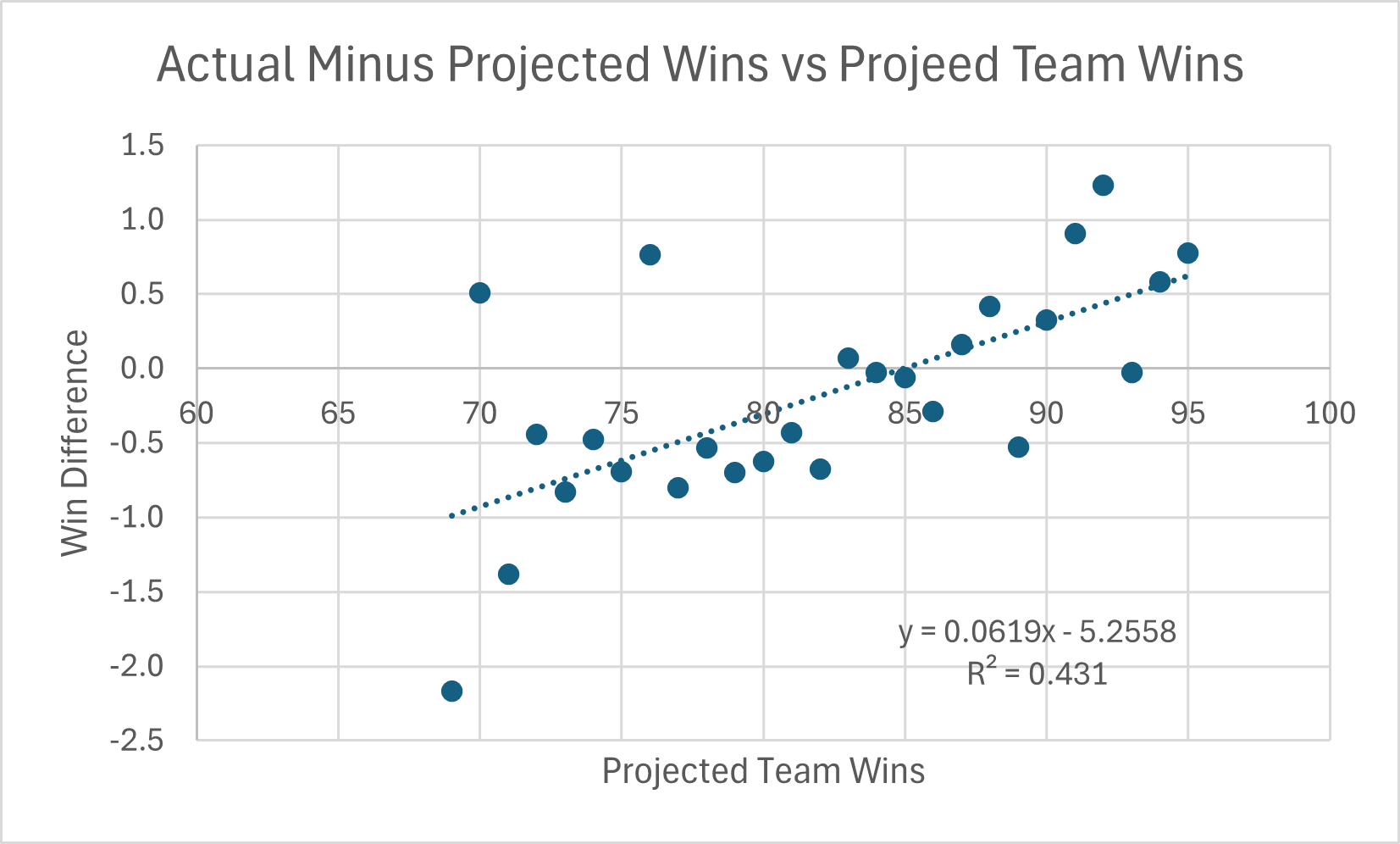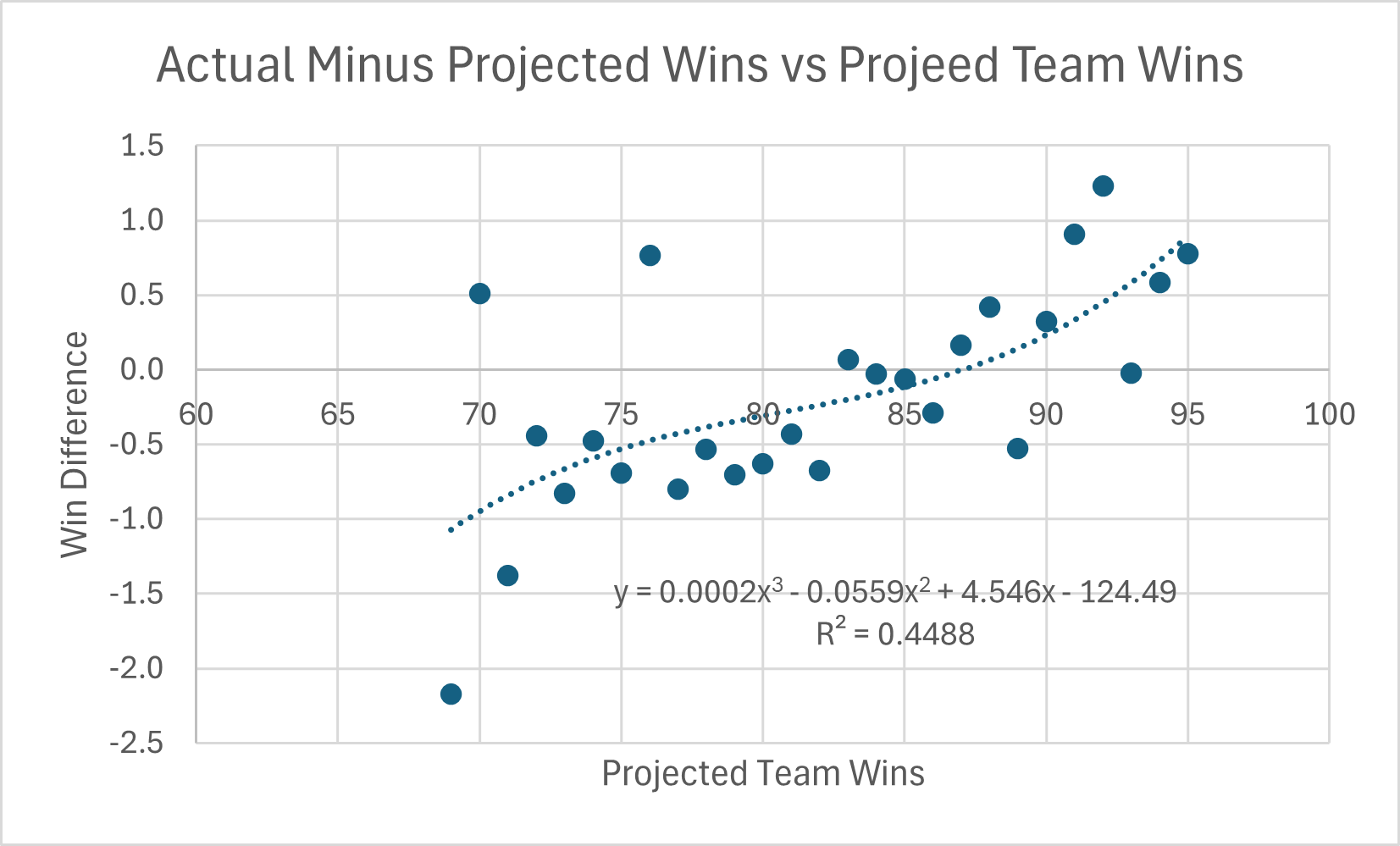Quick All-Star Break Study #2: Pitcher Wins Based on Pitcher & Team Talent
Over the break, I’m going to run a few quick studies. If you want to request, add it to this Twitter thread.
I am running a few quick fantasy baseball studies over the next few days. I'll take suggestions. The two I have planned:
1. If a hitter's AVG is below his projection, how much rebound is expected?
2. How much does a month's ERA/FIP/xFIP matter when looking forward?
— Jeff Zimmerman (@jeffwzimmerman) July 16, 2024
Over at the Pull Hitter Patreon, there was a discussion on starting pitcher Wins from shi … bad teams (e.g. Paul Skenes). Here are the results I found.
Parameters
- From 2010 to current
- Pitchers projected for 20 starts and got at least 10.
- I grouped pitchers by talent (projected ERA) and team-projected Wins.
- Injuries happen so I prorated the starts to 30. The projected Wins is greater than the actual Wins.
Here are the results
| Projected Team Wins | Avg Proj W | Av g Prorated Proj Wins | Actual Wins | Prorated Actual Wins | Diff (Prorated) | Count |
|---|---|---|---|---|---|---|
| Proj 4.75 to 5.25 ERA | ||||||
| <70 | 7.4 | 8.5 | 6.6 | 7.7 | -0.8 | 45 |
| 70 to 80 | 8.3 | 9.2 | 6.4 | 8.1 | -1.1 | 93 |
| 81 to 90 | 8.6 | 9.7 | 7.7 | 9.2 | -0.5 | 56 |
| >90 | 7.3 | 9.8 | 10.3 | 15.5 | 5.7 | 4 |
| Proj 4.25 to 4.75 ERA | ||||||
| <70 | 8.3 | 9.5 | 6.7 | 8.0 | -1.5 | 38 |
| 70 to 80 | 9.0 | 9.9 | 8.4 | 9.7 | -0.2 | 220 |
| 81 to 90 | 9.6 | 10.5 | 8.9 | 10.6 | 0.1 | 168 |
| >90 | 10.1 | 11.2 | 9.8 | 11.8 | 0.6 | 39 |
| Proj 3.75 to 4.25 ERA | ||||||
| <70 | 9.3 | 10.1 | 7.2 | 8.5 | -1.6 | 30 |
| 70 to 80 | 10.0 | 10.8 | 8.6 | 10.3 | -0.5 | 170 |
| 81 to 90 | 10.7 | 11.3 | 9.8 | 11.2 | -0.1 | 303 |
| >90 | 11.2 | 12.0 | 11.0 | 12.6 | 0.6 | 66 |
| Proj 3.25 to 3.75 ERA | ||||||
| <70 | 12.5 | 11.9 | 9.7 | 11.1 | -0.9 | 3 |
| 70 to 80 | 11.7 | 11.9 | 9.7 | 11.1 | -0.8 | 58 |
| 81 to 90 | 11.9 | 12.3 | 11.0 | 12.1 | -0.2 | 161 |
| >90 | 12.6 | 12.9 | 12.7 | 13.9 | 1.0 | 72 |
| Proj 2.75 to 3.25 ERA | ||||||
| <70 | – | – | – | – | – | 0 |
| 70 to 80 | 12.8 | 13.2 | 12.0 | 13.4 | 0.2 | 8 |
| 81 to 90 | 13.5 | 13.2 | 11.6 | 13.2 | 0.0 | 43 |
| >90 | 14.0 | 13.8 | 13.0 | 14.1 | 0.3 | 21 |
Notes:
- The projected Win difference for similar pitchers on different quality teams works out to less than two Wins.
- The actual difference between similar pitchers on projected (prorated) average to good teams (70 Wins or more) is around two to three Wins.
- The drop off from the 70 to 80 projected win teams to those under 70 Wins is two more Wins.
- The over and underestimating a pitcher’s prorated Wins can be seen in the Diff column where the range works out to around -1 to 1
Here is another way to look at projected versus actual Win difference. I grouped pitchers by team projected wins and found the average difference in prorated projected versus actual. The only difference between the two graphs is the best-fit line being linear and a polynomial.


From the above information, I have two takeaways.
- Similarly talented pitchers have similar expected and actual Win totals except on the worst teams (projected for fewer than 70 wins).
- Not much can be done now, but next preseason, it might be worth making a small adjustment to a starter’s projected Wins. I’m unsure if I’ll do it only for Steamer or across all projections. A comparison might need to be done on the Win total between different projection systems.
Jeff, one of the authors of the fantasy baseball guide,The Process, writes for RotoGraphs, The Hardball Times, Rotowire, Baseball America, and BaseballHQ. He has been nominated for two SABR Analytics Research Award for Contemporary Analysis and won it in 2013 in tandem with Bill Petti. He has won four FSWA Awards including on for his Mining the News series. He's won Tout Wars three times, LABR twice, and got his first NFBC Main Event win in 2021. Follow him on Twitter @jeffwzimmerman.
Do the various projection systems already adjust a player’s team-dependent statistics (e.g. Wins) for expected team quality? That really goes towards your second takeaway, I suppose. Different projection systems might incorporate that differently (or not at all)
I figured they did but maybe not.